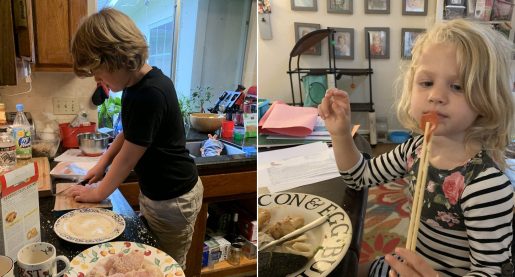Feeding children during the COVID-19 pandemic
I helped write the American Heart Association’s Scientific Statement about how caregivers can create a food environment which fosters good health in young children. And yet, as a parent of two young children, I am experiencing the challenges posed to this approach by the current COVID-19 pandemic.
The approach stressed giving children the autonomy to choose whether to eat, how much to eat and what to eat, within an environment that is structured by their caregivers to support the intake of healthy foods.
We noted that the focus of caregivers shouldn’t be directly on the child’s eating choices. Instead, caregivers should focus on setting consistent meal and snack times, limiting the availability of unhealthy foods and consistently serving and eating a wide variety of healthy foods (even if the child does not eat them).
These suggestions are supported by a strong body of scientific literature, and so I try to enact these guidelines with my own family.
But is it realistic during a pandemic?

The increased stress has made the appeal of using food as a reward stronger. My ability to be patient when children refuse the food I provide is weaker. It has made me less likely to model eating healthy foods such as fruits, vegetables and whole grains but rather more likely to eat highly caloric, nutrient-low “snack” foods.
Time pressures associated with juggling working with childcare has made grocery shopping for fresh food more sporadic. It’s reduced the time I have to cook and challenged my ability to provide a consistent eating routine. Suddenly, those behaviors I vocally promoted in public arena were falling away in my own home.
How any caregiver deals with this situation will reflect their own privileges, priorities and personal strengths. There is no one way to get through this challenging time. I find myself regularly checking in with my key goals in the eating environment, and letting others fall away.
I am focusing on making a variety of healthy foods available, and letting go of worrying about fancy serving options, or creating novel dishes. I am trying to make time for stress relief for all of us – mediation for me (and my son when he goes to sleep) and dance parties for the children – but this is much harder.
Friday night family movie night has become a full on “home movie theatre” event complete with blankets and “special seats” for everyone. And, even when all of that seems too much, I remember that the core advice for feeding children is two sided: caregivers should focus on providing a healthy food environment – but also try not to directly influence children’s eating behaviors.
On days when the “prove a healthy eating environment” part of our food environment takes a back seat for me, I have chosen to still give the children autonomy and freedom to select if they eat, what they eat, and how much they eat from their environment, and be at peace with this.
This is an unprecedented health situation which is rife with uncertainty. I remind myself that being able to support my children by ceding control to them can be more challenging than ever and, in and of itself, is a parenting win.
-By Alexis Wood, Ph.D, assistant professor of pediatrics-nutrition at Baylor College of Medicine



